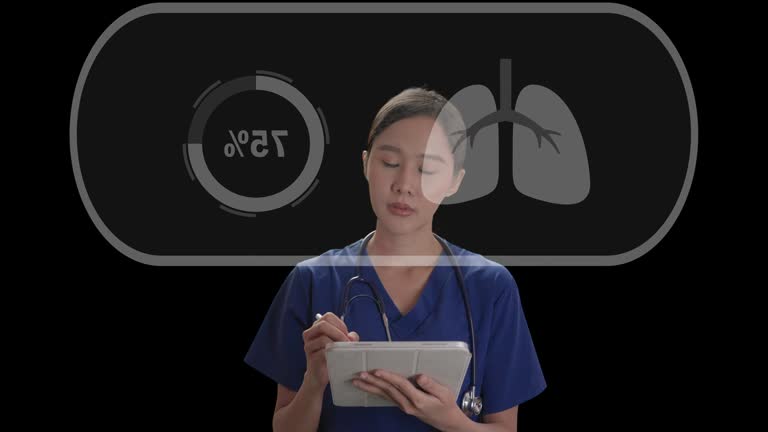Stethoscopes are simple yet powerful tools that doctors and nurses use to detect respiratory disorders. By listening to lung sounds, they can identify signs of asthma, pneumonia, bronchitis, and other lung problems. This process, called auscultation, allows healthcare providers to pinpoint what’s wrong and how to treat it. In this article, you’ll learn how stethoscopes aid in detecting respiratory disorders, where they are placed during exams, and why their role is so important in healthcare.
What Is Auscultation and Why Is It Important?
Auscultation is when doctors listen to the sounds inside your body using a stethoscope. It helps detect problems in your lungs, heart, and even your stomach. For respiratory issues, doctors listen to specific spots on your chest and back to hear how your lungs are working.
For example:
- Wheezing might mean you have asthma or a blocked airway.
- Crackling sounds could suggest fluid in your lungs, possibly from pneumonia.
Auscultation helps doctors decide what’s wrong without needing expensive tests right away.
Lung Auscultation Landmarks: Where Do Doctors Listen?
Doctors use specific areas on your body to listen for lung sounds. These areas are called lung auscultation landmarks, and they make sure no part of your lungs is missed.

Key Auscultation Sites of Lungs
- Anterior Chest (Front)
- Doctors listen above and below your collarbone to hear the upper parts of your lungs.
- They also check the mid-chest area for sounds coming from the middle of your lungs.
- Posterior Chest (Back)
- The area around your shoulder blades helps reveal sounds from the back of your lungs.
- The lower back areas allow doctors to hear the base of your lungs.
- Lateral Chest (Sides)
- The sides of your chest are crucial for detecting sounds that might not be clear from the front or back.
- Auscultation Triangle
- This triangular area on your upper back, formed by muscles and bones, provides the clearest lung sounds.
Using these landmarks ensures a complete examination of your lungs.
What Does Normal and Abnormal Lung Sound Mean?
Lung sounds tell a story about what’s happening inside your chest. Doctors compare normal and abnormal sounds to diagnose respiratory problems.
Normal vs. Abnormal Lung Sounds
| Type of Sound | What It Sounds Like | What It Could Mean |
| Vesicular | Gentle, rustling sound (normal) | Healthy lungs |
| Wheezing | High-pitched whistling | Asthma, airway narrowing |
| Crackles (Rales) | Popping or bubbling | Pneumonia, fluid buildup in the lungs |
| Rhonchi | Low-pitched rattling | Mucus blockage, chronic bronchitis |
| Stridor | Loud, harsh sound during breathing | Airway obstruction, possible emergency |
These sounds guide doctors in figuring out whether your lungs are healthy or if you need treatment.
How do Stethoscopes help with Heart Auscultation?
Stethoscopes aren’t just for the lungs. They’re also used to listen to your heart. Doctors listen to the 5 areas of the heart for auscultation to check for murmurs, irregular beats, or blocked valves.
Heart Auscultation Areas
- Aortic Area: Located on the right side of your chest, near the top.
- Pulmonic Area: On the left side of your chest, near the top.
- Erb’s Point: The center of your chest, just below the sternum.
- Tricuspid Area: Lower left side of your chest.
- Mitral Area: Near the apex of the heart, under your left breast.
These areas allow doctors to hear different parts of your heart and detect possible issues early.
Traditional Stethoscopes vs. Modern Technology
While stethoscopes have been used for centuries, modern technology is improving the way doctors listen to the body. Here’s a comparison:
| Tool | What It Does | Pros | Cons |
| Traditional Stethoscope | Amplifies body sounds manually | Easy to use, affordable, reliable | Requires training to interpret sounds |
| Digital Stethoscope | Records and amplifies sounds electronically | Can store sounds for later analysis | More expensive than traditional models |
| AI-Based Devices | Uses artificial intelligence to detect patterns | Can identify issues faster, great for research | Limited availability, costly |
Despite advancements, traditional stethoscopes remain irreplaceable for their simplicity and effectiveness.
The Role of Stethoscopes in Nursing and Emergency Care
Stethoscopes are not just tools for doctors. Nurses also use them in critical care settings, especially for understanding abnormal lung sounds and monitoring patients with respiratory conditions. In emergencies, a quick check of the auscultation triangle or specific lung areas can provide vital information.

In nursing, the process of checking lung auscultation landmarks is taught early, ensuring every area of the lungs is examined. Nurses also monitor breathing patterns, which is essential for patients recovering from surgeries or dealing with chronic illnesses.
Conclusion
Stethoscopes are indispensable in detecting respiratory disorders. They allow doctors and nurses to listen for abnormal lung sounds, assess heart function, and monitor overall health. By focusing on lung auscultation landmarks in nursing and the auscultation areas of the heart, healthcare providers can ensure no problem goes unnoticed.
From traditional stethoscopes to advanced digital models, this tool continues to save lives by offering a simple, effective way to diagnose illnesses early. Whether it’s hearing wheezing from asthma or detecting crackles in pneumonia, stethoscopes help healthcare professionals keep you healthy.
So, next time you see your doctor, remember how much this small device does for your health.


